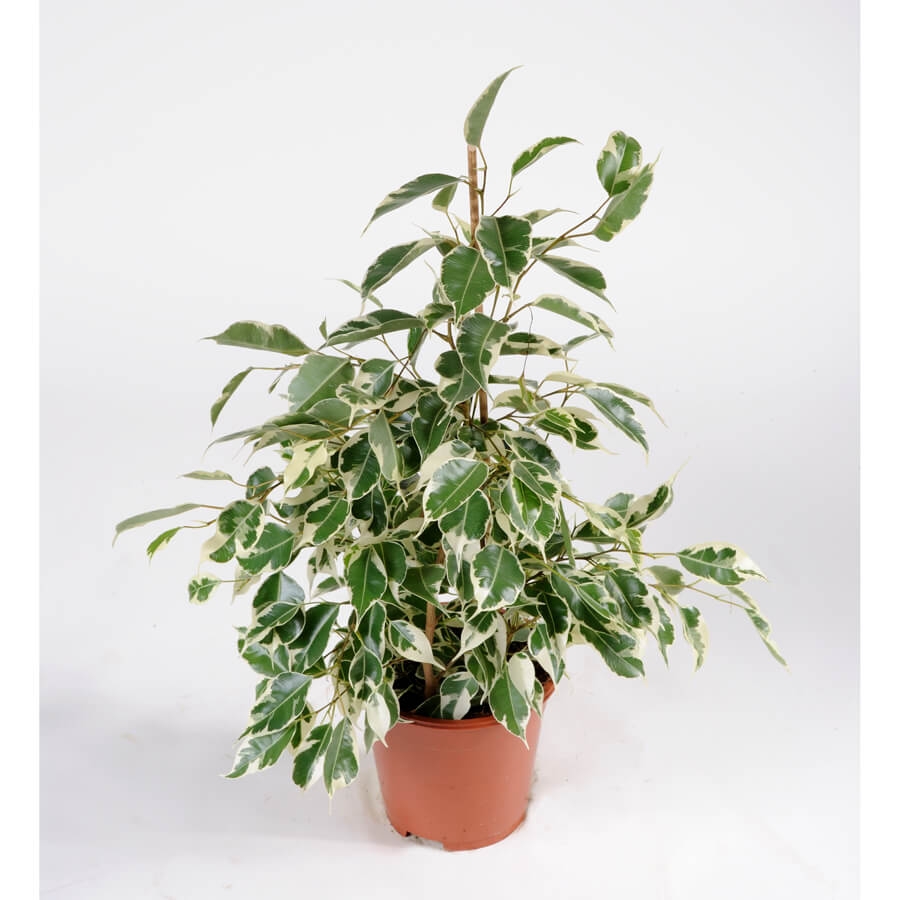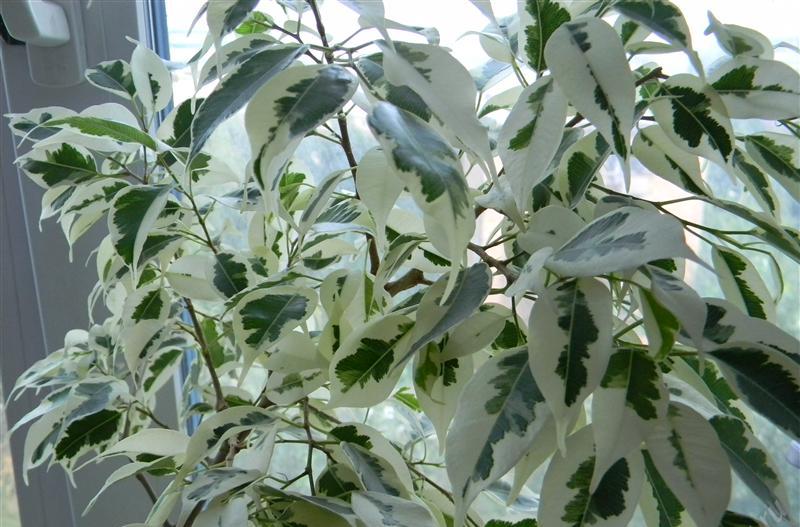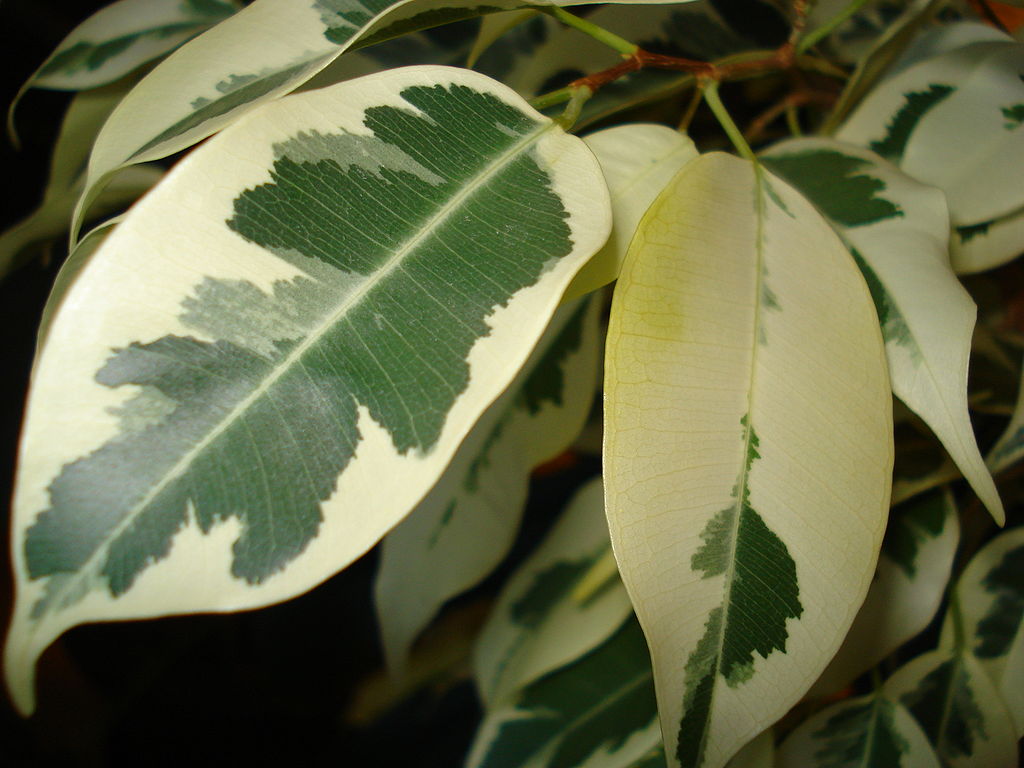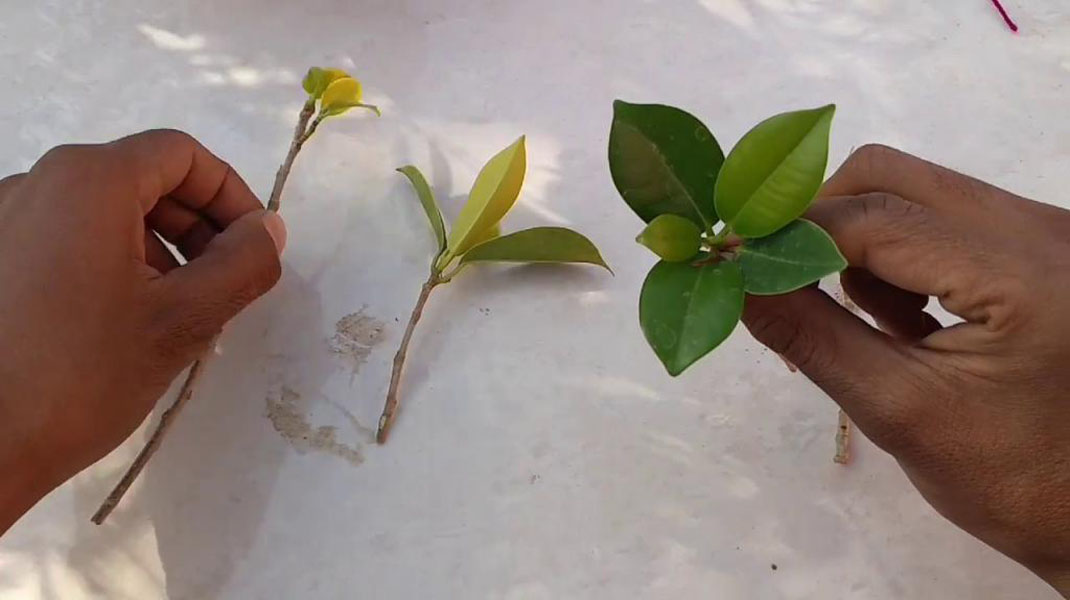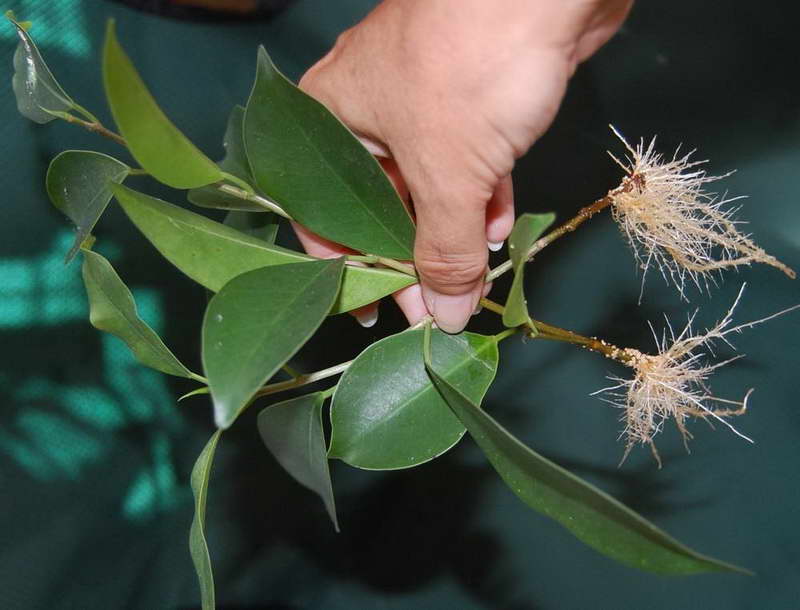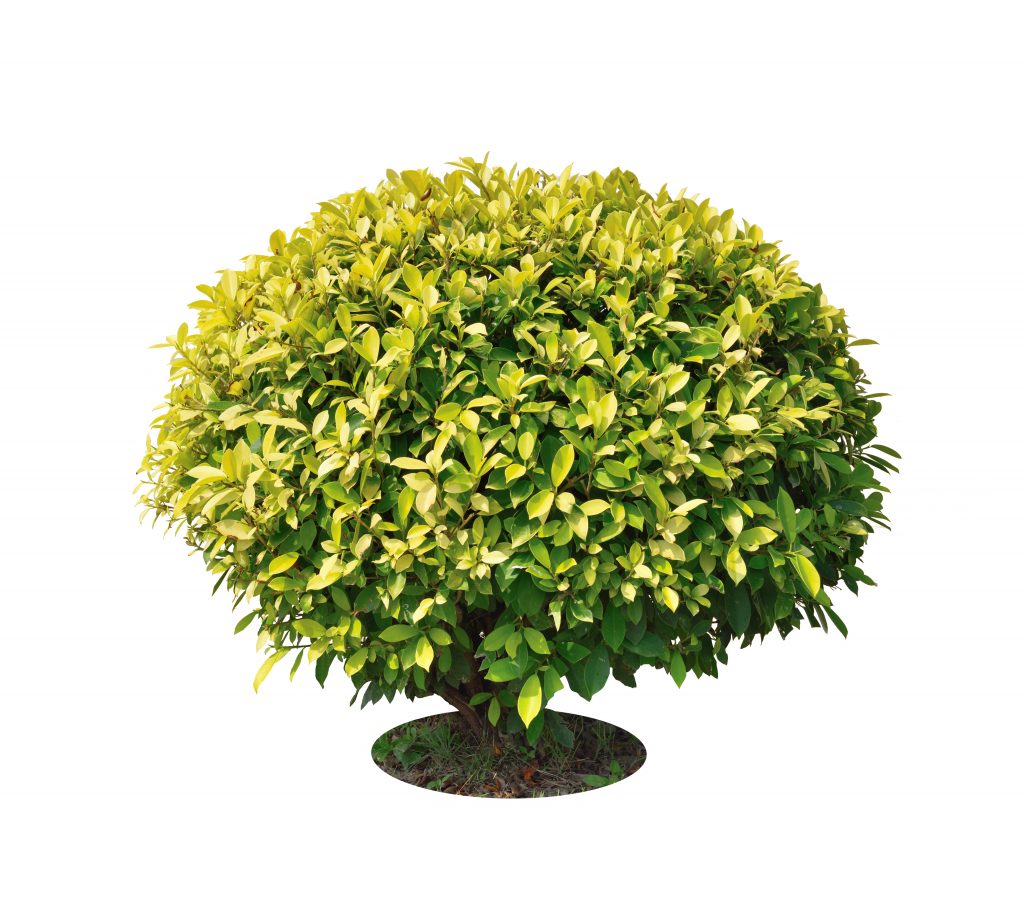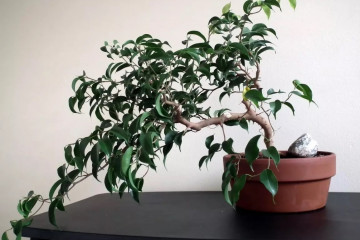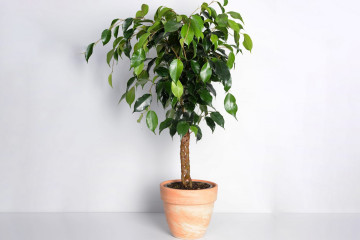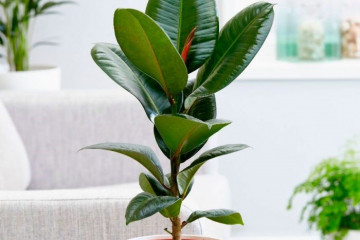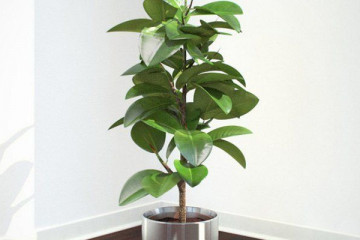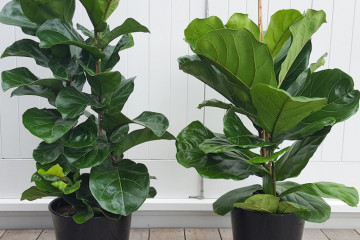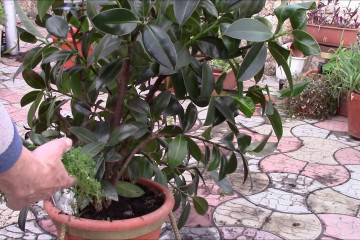Ficus Benjamin - home care
Content:
For the decoration of offices, houses or apartments, a plant called Benjamin's ficus is often used.
Origin and appearance
The evergreen belongs to the Ficus species, the Moraceae family. Habitat - the countries of East Asia, the north of the Australian mainland.
According to the ancient Chinese science of Feng Shui, a tree personifies wealth, money. It disinfects and cleans the surrounding air well.
The plant has a gray round trunk with single strokes of brown. Due to its flexibility and the possibility of growing together with other shoots, plants with intertwined trunks are created from it. Florists grow bonsai from it.
Young shoots are erect, lignify quickly with age. The crown is thick, wide.
The leaves are leathery, glossy, thin, oval in shape with a pointed end, located on small cuttings. They grow on twigs in the same plane. The edges of the leaf are smooth. The color and size of the sheet are determined by the species.
The flower of Benjamin's ficus is nondescript. Fruits are paired, round or oblong in shape, up to 2 cm in size, are called syconia.
The growth rate of domestic species is low. If you take good care of a tree, then it grows by about a meter in 10 years.
At home, ficus is a tree or shrub, up to 20-25 m high. An indoor plant grows up to 2-3 m.If you do not carry out molding and pruning, it grows to the height of the room.
Types and varieties
Ficus Benjamin has many varieties that differ from each other in shape, size and color of leaves and trunk, growth rate.
Ficus Natasha
The Natasha variety belongs to the dwarf varieties. It has glossy, small green leaves. In young shoots, the leaves are brighter and lighter, in older ones they are dark green. An adult plant grows up to 40 cm in height.
Ficus Kinki
Also applies to dwarf ficuses. It can grow up to 35-40 cm. The leaves reach a length of 4 cm. They have a dark green color with a yellow-beige or salad edging.
Ficus Ali
This species is also called ficus Benedict (Binnendijka) and willow. Named after the discoverer Simon Benedict. The bark of an adult tree is dark in color with light streaks. There are several varieties of Ali ficus, which differ in the color of the leaves (monochromatic or variegated).
The leaves are long (up to 30 cm) and narrow (5-7 cm wide).
Ficus Baroque or Baroque
Ficus Baroque leaves are distinguished by their original shape. They are twisted into a tube, donut or spiral. The front side of the leaf is glossy, has a light green color. On the back, it is more matte and has a less saturated green color.
The plant branches slightly, therefore, to create a beautiful bush, several seedlings are planted in a flower pot. The growth of the tree is rather slow.
Ficus Benjamin white
This is the combined name of several varieties in which the predominant color of the leaves is white. These include varieties:
- Starlight;
- De Dumbbell;
- Curley et al.
Ficus Benjamin mix
It has several varieties with different leaf colors. The subspecies is the least demanding in care. It is characterized by rapid growth and long life expectancy. Leaves are oval, thin, up to 10 cm long.
Ficus Binnendijka Amstel Green Gold
A tree with thin, drooping shoots, has a bushy shape. The plant is long-leaved, with thin, boat-shaped leaves. The length of the leaf reaches 25 cm, the width is up to 3.5 cm. The color is light green with dark green spots.
Ficus Benjamin variegated
The leaves of this variety contain both genetically normal cells and mutant cells that do not synthesize chlorophyll.
Therefore, they are always colorful.
Transplanting ficus Benjamin after buying into a pot
What is needed for landing
First, choose a plastic or ceramic flower pot that is 3 fingers larger than the root ball.
The soil is purchased at a specialized store, or you can make it yourself. For this, peat, sand and rotted manure, taken in equal parts, are well mixed. To the mixture add leafy earth, taken 2 times more than peat.
Expanded clay, pebbles, small crushed stone, pieces of foam plastic, charcoal can be used as drainage materials.
Optimal location
For a plant, it is advisable to choose a place where it will grow even before buying. When moved to another place, the tree is under stress, it can get sick and shed its leaves. Stress is one of the reasons why leaf fall can occur.
For a plant with monochromatic leaves, the eastern or southeastern window sill will be the best place. If the leaves are variegated, then the pot is placed on the southeast or south windowsill. In any case, the crown should not be exposed to direct sunlight, so as not to scorch the leaves.
Signs of burns - the leaf begins to turn yellow and dry out at the edges, pigmentation appears on it, and the leaf dies off.
If there is not enough light for the variegated ficus, the leaves will lose pigmentation and become monochromatic.
Also, the tree is afraid of drafts. Therefore, the flowerpot should not be installed near balconies and under air conditioners.
Step-by-step planting process
Ficus is transplanted into a new pot after purchase and then until the age of five (every year in spring or summer). When plant growth slows down, the transplant can be performed once every 2 years.
It is not recommended to transplant the tree immediately after purchase, as it must get used to the new place and acclimatize. During this period, the leaves may fall off the plant. This is a reaction to a change of residence. Adaptation lasts 1.5 weeks or a little more.
The transplant is performed in the following sequence:
- Preparing the flower pot. First, drainage is poured at the bottom, and a small layer of soil is poured on top.
- The tree is taken out of the shipping container, its roots are examined, rotten ones are removed. Places of cuts are powdered with charcoal powder.
- The flower is placed in a pot. The roots are spreading out.
- The remaining soil is filled up, it is tamped a little from above.
- If the soil was initially moistened, then it is necessary to water it no earlier than 2-3 days after planting.
Reproduction of ficus Benjamin
The plant can be propagated in the following ways:
- cuttings;
- air layering;
- seeds.
Cuttings
This is the easiest way to reproduce. Cuttings are cut no shorter than 7-10 cm with 3-4 leaves from the top of the lignified shoots. A distance of at least 2 cm is left from the first sheet to the cut.
Milky sap appears at the site of the cut of the cutting. It is removed and the stalk is placed in a glass of water.After a while, the roots of the cut shoot will appear.
Growing from seeds
Before planting, the seeds are soaked in water with a growth stimulator. When planting, they are buried in the ground to a depth of 0.5 cm with a step of 1.5 cm. A spray bottle is used to moisten the substrate. From above, the container is covered with polyethylene or glass. The greenhouse is periodically ventilated.
After emergence, the container is placed on a well-lit windowsill. The light should be diffused. The temperature is maintained within + 22-25 ° С. Watering is carried out as the soil dries out.
After the appearance of the first leaves, a pick is carried out and the strongest seedlings are transplanted into separate pots.
Benjamin Ficus Care
At home, caring for Benjamin's ficus is simple. It consists in the correct organization of irrigation, the creation of optimal temperature conditions and illumination.
How to water
The plant loves moderately moist soil. Therefore, in the summer for the ficus Benjamin, you need to organize frequent watering. So much water is needed so that after watering it goes into the pan. If the summer is dry, then the plant is sprayed.
Top dressing
For normal development during the growing season, the tree is fed with complex mineral fertilizers every 2 weeks.
Crown formation and pruning
To form a beautiful crown of a tree, you need to regularly prune. First, the top of a young plant is cut into 2 buds. Then the branches are pruned periodically every 3 years. It is advisable to carry out this operation in the spring.
Pruning rules:
- make a cut at an angle;
- pruning is performed over the place where the kidney is located;
- use a clean sharp tool for work.
Preparing for winter
Ficus is an evergreen plant, therefore, if in winter it begins to shed its leaves, then this may be due to a lack of lighting. In this case, artificial lighting is arranged for the tree. The total daylight hours in winter should be about 12-14 hours.
In winter, the air humidity should be 60-70%, so the plant is additionally sprayed with a spray bottle. With a lack of moisture, the tree sheds its leaves.
If the flowerpot is located on a windowsill, then you need to protect the plant from touching cold glass.
If the pot is on the floor, then it is advisable to raise it. You can install it on an insulating piece of fabric or wood.
If ficus Benjamin has sticky leaves
Ficus diseases can be caused by damage to the plant by insects, microorganisms, fungi and mold.
The defeat of fungi can be determined by the spots that appear on the leaves of brown, red, yellow colors, which grow quite quickly. After that, the leaf dies off.
Sometimes the appearance of fungal diseases provokes insect damage to the plant. So, for example, if aphids or scale insects have settled on a tree, then the leaves are covered with a sticky sweetish bloom. If the plaque is not removed in time, then the plant will eventually be affected by a sooty fungus.
In this case, you must first remove the cause, that is, aphids or scale insects. For treatment, the leaves are washed with soapy water. The treatment of the plant must be repeated several times until the insect and plaque are completely removed. Also, the affected tree is treated with Aktara or other similar means.
How to reanimate if the leaves have completely fallen
With improper care or damage to the plant, leaf fall can shed foliage in a few days. A complex of reasons can lead to this. The resuscitation process consists of the following stages:
- Finding out the reason for leaf fall. It may be caused by poor (insufficient or excessive) watering. Check how well the watering was organized. To do this, they pierce the ground at the root with a wooden stick and pull it out. If it is dry, then you need to water the plant.
- If the leaf fall occurred due to the fault of parasites, then first they get rid of them.Then the plant is periodically sprayed with Zircon, Epin or similar preparations that will help fight stress.
- Adjust conditions of detention.
- If there are no positive results, then the plant must be taken out of the pot and the root system must be examined, rotten roots removed and transplanted into a new pot.
- A bare tree can be placed in a plastic bag and created a mini-greenhouse until it is fully restored.
Ficus is a very beautiful and not very demanding plant that will perfectly fit into the interior of any home.
